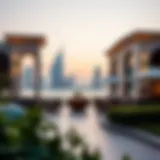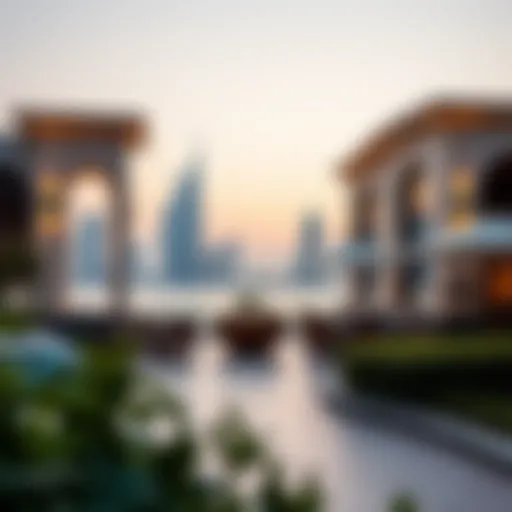Impact of Burj Khalifa on Dubai's Real Estate in 2020
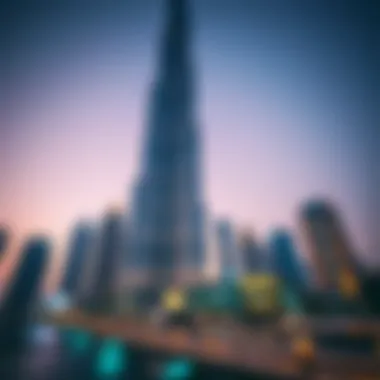

Intro
In the grand tapestry of Dubai's landscape, the Burj Khalifa stands as not just a structure, but as a defining emblem of the city's ambition and progress. Since its completion in 2010, this architectural marvel has not only changed the city’s skyline but has also significantly influenced the real estate dynamics in 2020, particularly against the backdrop of a global pandemic. With its sheer height and innovative design, the Burj Khalifa has sparked a wave of interest from investors, expatriates, and developers alike.
This article dives into the intricate implications of this tall building on the real estate scene, bringing to the fore trends in property values, investment possibilities, and the broader changes in lifestyle that followed its establishment. By examining market data, insights from industry experts, and local sentiments, a clearer picture emerges of how the Burj Khalifa has shaped, and continues to shape, the aspirations of various stakeholders in Dubai's real estate market.
Foreword to Burj Khalifa
The Burj Khalifa stands as one of the most iconic structures not only in Dubai but across the globe. Its towering height is symbolic of ambition and innovation that has defined the city’s growth. In this article, we will delve into its various impacts on the real estate landscape of Dubai, particularly during the pivotal year of 2020. Understanding the Burj Khalifa is essential to grasp how it has shaped property values, inspired development, and influenced investor behavior in the region.
Historical Context
The inception of the Burj Khalifa dates back to the early 2000s, with its construction beginning in 2004 and officially opening in January 2010. Initially named Burj Dubai, it was later rebranded in honor of Sheikh Khalifa bin Zayed Al Nahyan, the ruler of Abu Dhabi. The building was designed to be a beacon of Dubai’s resurgence following the economic challenges earlier in the millennium. As such, it became a symbol of resilience and growth, generating a new set of expectations in real estate and tourism alike.
In 2020, as Dubai grappled with the global pandemic's effects, the Burj Khalifa's historical significance took on new dimensions. It served as a reminder of the pre-pandemic vibrancy while also becoming a focal point of recovery strategies in the wake of economic downturns.
Architectural Significance
The architectural prowess of the Burj Khalifa cannot be overstated. Designed by the acclaimed architectural firm Skidmore, Owings & Merrill, the building rises to an astounding 828 meters and comprises 163 floors. The design is inspired by traditional Islamic architecture, specifically reflecting the pattern of a desert flower.
This structural marvel not only houses luxury residences and corporate offices, but also attracts millions of tourists annually. The viewing platform on the 148th floor offers spectacular views of the city, becoming a coveted point for touristic engagement. The Burj Khalifa's exquisite design has influenced other high-rise developments in Dubai, establishing a benchmark for luxury and modern living.
Cultural Impact
Beyond its physical presence, the Burj Khalifa has embedded itself into the cultural fabric of Dubai. It is more than a skyscraper; it is a symbol of national pride and aspiration. The building frequently serves as a backdrop for events, celebrations, and international gatherings, launching visual spectacles like the annual New Year's Eve fireworks and light shows.
The cultural significance also extends to its role in media and entertainment. Movies, documentaries, and countless photographs feature the Burj Khalifa, enhancing its global status. Thus, the influence of the Burj Khalifa reaches far beyond architecture, impacting tourism, cultural identity, and even social dynamics within the region. For investors, the attraction it generates bodes well for property values and business opportunities in its vicinity.
The Burj Khalifa is not just a building but a landmark that encapsulates the spirit of Dubai, inspiring both visitors and investors alike.
Overall, the foundation laid by the Burj Khalifa is vital for understanding Dubai’s real estate dynamics as we move deeper into 2020 and beyond. Its multifaceted impacts—historical, architectural, and cultural—offer critical insights into the unfolding narrative of one of the world's most dynamic real estate markets.
Real Estate Market Overview of Dubai in
The real estate market in Dubai has always been a focal point, reflecting the city’s rapid development and its ambitions on the global stage. In 2020, Dubai experienced a distinctive shift. The influence of external factors, especially the pandemic, significantly transformed the landscape. Thus, understanding the state of the market in that year is key to grasping broader trends and potential futures for investors, developers, and residents alike.
Market Trends
In 2020, the real estate market in Dubai showed various trends driven by dynamic conditions. One of the notable observations was the increased inclination toward spacious homes. Due to the pandemic, more individuals were working from home, prompting a demand for larger living spaces. This was coupled with a need for amenities that could support remote work and leisure, like home offices and outdoor areas. Popular areas such as Dubai Marina and Jumeirah Beach Residence saw renewed interest, along with suburban neighborhoods like Dubai Hills Estate.
Moreover, transaction volumes saw a peculiar evolution during 2020. Initially, as the pandemic broke, the market experienced a slow down, but towards the end of the year, recovery became apparent. There was a notable uptick in transactions, especially in the off-plan property market. Investors were eager to take advantage of the discounts offered by developers to stimulate sales.
- Key Trends in 2020:
- Increased demand for spacious homes
- Rise in off-plan property transactions
- Greater interest in suburban living
Investment Peaks
Investment peaks in Dubai’s real estate sector in 2020 were closely intertwined with the Burj Khalifa’s presence. The skyscraper has acted as a catalyst, drawing investors not only for its aesthetic but also for its symbolic representation of luxury and prosperity. During the year, despite the economic slowdown caused by Covid-19, several high-profile developments were launched, targeting a balance between affordability and luxury.
Notably, the off-plan projects garnered substantial interest, spurred by lower prices and payment plans that catered to first-time buyers and foreign investors. Areas within proximity to Burj Khalifa, like Downtown Dubai, remained desirable for buyers seeking premium investments, as these properties tended to retain their value better than others amid fluctuating conditions.
Post-Pandemic Recovery
By the latter half of 2020, the Dubai real estate market began to show signs of recovery from the pandemic's initial shock. As restrictions eased, several economic initiatives were rolled out, boosting confidence among investors. The introduction of incentives for expatriates and flexible visa rules also played a role in reviving market sentiment.
- The following actions contributed to recovery:
- Government initiatives to encourage remote working
- Measures to support foreign investors and expatriates
- Optimistic market forecasts
"By capturing a slice of Dubai's evolving real estate narrative in 2020, investors could strategically position themselves for what lies ahead, especially given how the landscape shifted so dramatically."
Overall, the real estate market in Dubai during 2020 was marked by unique challenges and transformations, influenced greatly by the pandemic, yet also by the enduring allure of landmarks like the Burj Khalifa. Investors had to stay agile, adapting to changes while seizing available opportunities, recognizing the interplay between the dynamics of supply, demand, and location.
Burj Khalifa's Influence on Property Values
The Burj Khalifa serves as more than just an architectural triumph; it has significantly swayed property values around its vicinity in Dubai. This section explores how the presence of this iconic skyscraper has resulted in noticeable shifts in both residential and commercial property valuations, alongside rental market fluctuations. The importance of these changes lies not only in their immediate effects but also in the lasting legacy of Burj Khalifa on Dubai's real estate landscape.
Residential Developments
In 2020, residential properties near the Burj Khalifa experienced a marked increase in desirability and, consequently, value. The allure of living close to the tallest building in the world contributes to a premium placed on real estate in the area. People often gravitate towards the luxury and lifestyle that such a landmark promises.
Moreover, developments like the Dubai Mall Residences have capitalized on the flow of tourists and residents flocking to the area. This influx drives demand, leading to a rise in property prices.
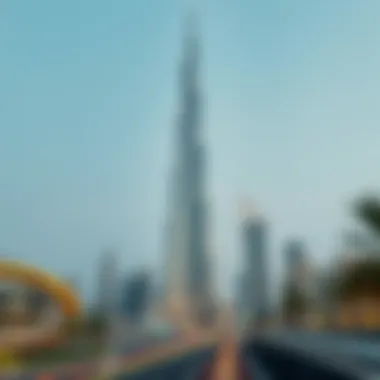

- Increased amenities attract buyers.
- Proximity to landmarks enhances allure.
- Resale values appreciate over time.
Potential investors are now looking at this trend as a sign that buying into this market offers strong returns. The integration of world-class facilities and the ongoing branding of the area make it hard to overlook for those seeking long-term gains.
Commercial Properties
Burj Khalifa has also reshaped the commercial property sector in Dubai. Office spaces in the vicinity are seeing a rise in demand, influenced by the prestige associated with having an address near the landmark. Many companies see value in being close to a globally recognized structure, as it boosts their brand visibility and prestige.
In 2020, major corporations began to establish headquarters in the area, which further elevated the rental rates for office spaces.
The statistics don’t lie:
- Commercial rentals near Burj Khalifa increased by approximately 15%.
- High-end brands seek flagship stores in the Burj Khalifa vicinity, enhancing foot traffic.
- New skyscrapers and mixed-use developments are emerging in response to the demand.
This pattern suggests that owning commercial property near the Burj Khalifa is not just a trend but a savvy investment strategy. Not only are they benefiting from heightened visibility, but they are also poised for future growth as developments surge.
Rental Market Changes
With growing interest in both residential and commercial properties, the rental market by Burj Khalifa has evolved considerably. In 2020, there was a notable shift in rental prices, with many landlords capitalizing on the building's iconic status to command higher rents.
Research indicated the following impacts:
- Average rents for residential apartments surged by nearly 10%.
- Short-term rentals experienced boosts from tourism, pushing landlords to focus on platforms like Airbnb or Booking.com.
- Tenants are starting to prefer furnished apartments with premium amenities.
This has led to a competitive rental market where prospective tenants must act quickly to secure properties. Landlords, understanding the soaring demand, tend to market their properties aggressively, leading to properties being snapped up at lightning speed.
In summary, the Burj Khalifa is not merely a stunning visual centerpiece of Dubai; it fundamentally alters property values. The changes in residential and commercial sectors alongside shifts in the rental market form a complex ecosystem influenced by this tall structure. Investors are watching closely, recognizing the stabilizing influence and growth potential that the Burj Khalifa pulse through Dubai's real estate arena.
Demographics and Buyer Behavior
Understanding demographics and buyer behavior is crucial for grasping the real estate dynamics in Dubai amid the transformative influence of Burj Khalifa. The tower acted not just as a landmark but as a catalyst for shifting societal landscapes, altering who buys properties, their motivations, and how they navigate the market. Buyers today have a myriad of factors influencing their decisions, from lifestyle choices to economic conditions. Supporting responses to these trends is key for investors and developers alike.
Expats and Foreign Investors
Dubai's unique positioning as a global hub has attracted a significant influx of expatriates and foreign investors. The Burj Khalifa stands as a symbol of this international reach. In 2020, amidst fluctuating global economies, many foreigners saw Dubai as a safe haven. Expats, motivated by either job opportunities or lifestyle aspirations, have increasingly viewed the property market there as promising.
- Property Appeal: Many opt for high-rise living, often seeking residences near iconic landmarks like the Burj Khalifa or waterfront properties.
- Investment Trends: Foreign investments surged, especially in off-plan projects, reflecting confidence in Dubai's recovery and growth.
A detailed overview shows that close to 80% of property buyers in 2020 were expatriates, signaling a booming market driven by international demand. Despite challenges posed by economic fluctuations, this trend underscores the resilience of Dubai's real estate sector.
Local Buyer Trends
Local buyers have their unique landscape shaped significantly by cultural expectations, economic stability, and the market's evolution. In 2020, there was a notable shift in their preferences, influenced by the COVID-19 pandemic shifts in lifestyle and work. Many locals began seeking larger homes as remote work became a norm.
- Shifts in Demand: There was a marked increase in the demand for villas or townhouses offering outdoor spaces, prioritizing family-oriented lifestyles over urban apartments.
- Investment Behavior: Local buyers often leaned towards value purchasing, attracted by competitive pricing in a sluggish market.
Additionally, many opted for properties embodying luxury and modernity, often echoing the sophisticated design of the Burj Khalifa, which represents status as much as it does a place to live.
Lifestyle Preferences
Buyers' lifestyle preferences have grown increasingly diverse, shaping how properties are marketed and sold. As Dubai continues evolving, so do its residents' tastes, particularly those influenced by the Burj Khalifa's iconic status. It's not just about a home but a lifestyle, with various amenities that cater to an upscale living experience.
- Trendy Amenities: Properties with integrated smart technologies or proximity to leisure activities have gained traction, as this aligns with modern buyers' preferences, influenced heavily by a cosmopolitan lifestyle.
- Community Feel: Buyers show a keen interest in developing neighborhoods that foster community engagement, often looking for a balance between vibrant urban life and peaceful residential areas.
Ultimately, the Burj Khalifa exemplifies not merely an architectural feat but a benchmark for living standards, impacting buyer behavior by setting high expectations for residential properties.
"The Burj Khalifa has not just changed Dubai's skyline; it has reshaped our understanding of space and life in this city."
It’s essential for developers and investors, knowing these shifts and trends, to align their strategies with the evolving preferences of both local and foreign buyers as we head into more dynamic years ahead.
Impact of Burj Khalifa on Urban Development
The Burj Khalifa stands as more than just a monument of architectural prowess; it is a catalyst for urban transformation in Dubai. The impact of this iconic structure extends well beyond its height, influencing various facets of urban development in the city. In this section, we uncover how the Burj Khalifa has played a crucial role in contemporary urbanism by fostering infrastructure and community growth, shaping not just the skyline but also the identity of Dubai itself.
Surrounding Infrastructure Improvements
The construction of the Burj Khalifa prompted extensive upgrades to the surrounding infrastructure. Roads, public transport, and utilities have all been developed to support the influx of residents and tourists in the area. Enhancing accessibility, the Dubai Metro found its way to Downtown Dubai, where the Burj Khalifa is prominently located. This connectivity not only makes visiting the tower easier but also encourages prospective residents and businesses to flock to the vicinity.
Moreover, the pedestrian-friendly enhancements have transformed the surrounding area into a vibrant urban space. Walkable pathways, parks, and recreational areas have emerged, encouraging community interaction. Improved public transport is coupled with a network of pedestrian bridges, making it easier to access nearby attractions like the Dubai Mall and the Dubai Fountain.
"The establishment of the Burj Khalifa has redefined urban planning in Dubai, turning the area into a bustling hub of activity."
New Neighborhoods Evolving
As a ripple effect of the Burj Khalifa's presence, new neighborhoods have begun to manifest around it. The project not only serves as a focal point but also encourages residential developments such as The Address Residences and Downtown Views. These neighborhoods are designed to cater to diverse demographics, attracting both expats and the local population seeking a luxurious urban lifestyle.
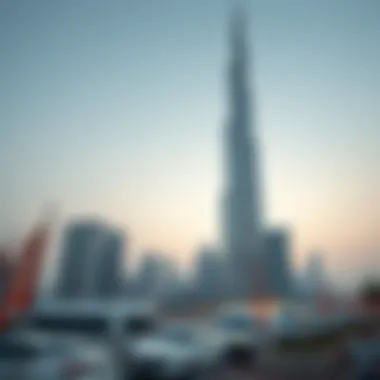

The properties in these neighborhoods often come with amenities that reflect the upscale nature of the Burj Khalifa itself. Frontrunners in the Dubai real estate market, these developments offer breathtaking views, high-end retail options, and a plethora of leisure activities.
In addition, the growth of communal spaces has fostered a sense of belonging among residents. Cafes, art installations, and weekend markets are becoming common sights, turning this area into a dynamic community environment.
Future Developments Inspired by Burj Khalifa
Looking towards the future, the Burj Khalifa sets the bar high for upcoming projects in Dubai. Its architectural marvel has inspired various developers to pursue innovative designs and concepts, blending aesthetics with practicality. Projects like the Museum of the Future and the Dubai Creek Tower (aiming to be taller than Burj Khalifa) are testaments to this inspiration.
These new developments not only aim to attract global attention but also enhance the cultural fabric of the city. It is expected that upcoming architectural projects will continue to draw from the success and allure of the Burj Khalifa, contributing to Dubai's status as a global hub of design and innovation.
Furthermore, the increasing focus on sustainable architecture and smart city concepts suggests that the legacy of Burj Khalifa will influence future urban developments positively. Developers are likely to integrate green technology and eco-friendly designs, ensuring that the growth aligns with global sustainability trends.
In summary, the Burj Khalifa remains a turning point in urban development strategies in Dubai. Its significant influence spans infrastructure improvements, evolving neighborhoods, and future developments that will continue to shape the city for years to come.
Tourism and Economic Impact
The Burj Khalifa has become a linchpin in Dubai’s economic fabric, particularly in 2020. Its stature not only draws tourists from around the globe but also stimulates various sectors linked to the tourism economy. Understanding this interplay reveals how entwined the fortunes of real estate and tourism are in this glittering city.
Visitor Statistics
In the wake of the pandemic, travel restrictions hit hard, yet Dubai managed to bolster its position as a top tourist destination even with these obstacles. In early 2020, around 15 million visitors passed through the airport, demonstrating a resilience typical of a city synonymous with opulence. Many flocked to see the Burj Khalifa, often hailed as the centerpiece of Dubai.
- Average Daily Visitors: The observation deck on the 148th floor attracted about 1,500 guests daily.
- Diverse Origins: Tourists hailed from different parts of the world, including Europe, Asia, and the United States, showcasing the Burj Khalifa as a global icon.
These statistics underscore the building's magnetic pull, which in turn impacts local real estate, as burgeoning tourist traffic drives demand for hospitality and residential properties.
Shopping and Entertainment Growth
Adjacent to the Burj Khalifa lies Dubai Mall, one of the largest shopping centers globally, which in 2020 saw a noticeable uptick in both foot traffic and spending. The proximity of retail spaces to iconic attractions like the Khalifa encourages spending sprees among visitors. Local businesses flourished, benefitting from the increased consumer activity.
Some key factors contributing to this growth include:
- Unique Experiences: Tourists engage in shopping combined with entertainment—think indoor ice skating or virtual reality experiences—which enhance their stay.
- Luxury Brands: The presence of high-end brands and outlets has made the area a beacon for affluent shoppers, often leading to longer stays in Dubai.
- Culinary Appeal: Fine dining restaurants specialized in international cuisines around the Burj Khalifa – from gourmet to fusion – appeal to the taste buds of diverse visitors, fostering a vibrant economy.
Employment Opportunities Created
As tourism flourished, so did the job market surrounding the Burj Khalifa. The building functions not merely as a lofty point of interest but as an economic driver generating jobs across several sectors. Here’s what unfolded:
- Hospitality Sector: Hotels in the vicinity expanded their services, creating numerous roles ranging from management to service staff.
- Retail Marketplace: Shopping outlets in Dubai Mall employed thousands, accommodating not just customers but enhancing their overall experience.
- Tour Activities: Companies offering guided tours or experiences related to the Burj Khalifa saw a demand surge, leading to further job creations in that niche.
"Opportunities abound where the Burj Khalifa stands tall. From hospitality to retail hiring, the economic ripples are numerous and widespread."
In summary, the Burj Khalifa’s role in boosting tourism and economic development in Dubai is significant. As the city’s iconic tower continues to attract millions, it simultaneously shapes the real estate market, providing ample opportunities for investors and developers alike.
Challenges Facing the Real Estate Sector
The real estate sector in Dubai, with its dynamic landscape, faces a unique set of challenges, particularly in a year as tumultuous as 2020. Understanding these challenges is critical for investors, developers, and anyone engaged in the market. This section will delve into three pivotal issues: sustainability concerns, market saturation risks, and regulatory issues that shape the environment of property investments in this bustling city.
Sustainability Concerns
In recent years, sustainability has shifted from a mere buzzword to a central tenet of real estate development. The rapid growth of Dubai's skyline, heavily marked by structures like the Burj Khalifa, raises eyebrows regarding the ecological imprint left on the environment. Concerns include resource consumption, energy efficiency, and the overall carbon footprint of ongoing projects.
Investors and developers must consider the long-term viability of properties. Buildings that prioritize green features—like energy-efficient designs, sustainable materials, and reduced water usage—are gaining traction. These elements foster not only positive community sentiment but also compliance with government regulations aimed at promoting a greener future. Therefore, investments that emphasize sustainability are not just ethical decisions; they can also yield better returns.
Market Saturation Risks
When a city experiences rapid growth, it can often lead to the dreaded saturation of the market. In Dubai’s case, the iconic Burj Khalifa catalyzed a rush of high-end projects competing for a share of the luxury market. Investors now need to be keenly aware of how oversupply can influence pricing and market dynamics.
Some key factors to consider include:
- Property Type Demand: Not all types of properties gain equal traction in the market. For instance, high-rise towers might become oversaturated, pushing investors toward more niche segments.
- Economic Conditions: Fluctuations in the global economy can lead to decreased demand for luxury properties, creating excess inventory.
- Market Trends: Monitoring demographic shifts is crucial. Expats may prefer smaller, more affordable units that align with evolving lifestyle preferences.
Regulatory Issues
Navigating the regulatory landscape in Dubai can be akin to walking through a minefield. The legal environment, while improving, still poses challenges for both developers and investors. Uncertainties regarding ownership laws, property taxation, and zoning regulations can create potential roadblocks.
- Ownership Regulations: Although ownership laws have been relaxed, varying regulations across different areas can confuse property buyers.
- Licensing Requirements: Developers are required to understand the fluctuating licensing requirements before commencing projects, which can delay timelines and inflate costs.
- Foreign Investment Policies: Changes to policies regarding foreign ownership can impact investor confidence, ultimately influencing market growth.
A clear understanding of these regulatory issues not only aids in risk management but also enhances strategic planning.
"The best investment on Earth is earth itself." - Louis Glickman
In summary, the challenges within Dubai's real estate sector in 2020 are intricate and multi-faceted. Stakeholders must address sustainability, market saturation, and regulatory complexities to harness the full potential of this vibrant market. The path won't be without hurdles, but with informed decision-making, investors can navigate the waters successfully.
Strategic Investment Insights
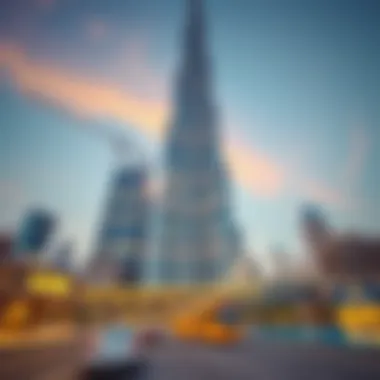

In the dynamic** realm of real estate,** the ability to identify promising investment opportunities can define success. This section dissects how the iconic Burj Khalifa shapes investment strategies for stakeholders in Dubai. Recognizing the nuances of this influence is crucial for investors, realtors, architects, developers, and expatriates in the bustling city.
Identifying Opportunities
Investors looking to delve into Dubai’s real estate market in 2020 were met with a landscape rich in possibilities. The stunning profile of Burj Khalifa not only stands as an architectural feat but amplifies its surrounding area’s allure for potential buyers and tenants.
Several key opportunities emerge from its presence:
- Proximity to Luxury: Properties close to the Burj Khalifa demand higher prices, highlighting the appetite for luxury in Dubai. Investors with properties in Downtown Dubai recognized the trend and adjusted their strategies accordingly.
- Mixed-Use Developments: With the Burj Khalifa acting as a catalyst, numerous mixed-use projects were initiated. Projects like Dubai Mall and the Dubai Fountain created a vibrant community atmosphere, enticing both residents and businesses.
- Expanding Tourism Sector: The reality that tourists flock to sights like Burj Khalifa means increased demand for short-term rentals. This growth is something savvy investors capitalized on.
Identifying these trends requires not just awareness, but a keen analytical eye. Understanding which developments are thriving can help steer investment choices effectively.
Risk Management Strategies
Entering a bustling market, especially one influenced by landmarks like Burj Khalifa, carries inherent risks. However, implementing thoughtful strategies can mitigate these challenges. Investors should consider the following strategies:
- Diversification: Avoid putting all eggs in one basket. By spreading investments across various property types, from residential to commercial, risk is naturally diluted.
- Monitoring Market Trends: Keeping a finger on the pulse of the market can arm investors with valuable foresight. Engaging with resources like Dubai Land Department can provide real-time insights.
- Engaging Local Expertise: Collaboration with local real estate agents who understand the nuances of the Dubai market gives a competitive edge. These professionals can help navigate regulatory frameworks and market fluctuations.
These strategies are not just preventative measures; they can create a path toward sustained growth and success in the long run.
Long-term Outlook
Looking ahead, the longevity and durability of investments in Dubai's real estate market are promising, thanks in large part to the iconic presence of Burj Khalifa. The economic landscape is shaped by several key factors:
- Sustained Demand: As Dubai continues to position itself as a global hub for business and tourism, property demand will likely soar.
- Urban Development Programs: Initiatives focusing on enhancing infrastructure and connectivity around major landmarks signal growth potential. The government’s commitment to development ensures ongoing investment.
- Innovative Technologies: The integration of technology in real estate operations, such as data analytics for market predictions and smart home innovations, positions Dubai favorably against global competition.
"The Burj Khalifa is not just a building; it’s an embodiment of Dubai's ambition, attracting investors and shaping futures".
For more insights on the Dubai real estate market, consider visiting Dubai Land Department or exploring community discussions on resources like Reddit.
Future Considerations for Dubai's Real Estate
The real estate landscape in Dubai is akin to a kaleidoscope—dynamic, colorful, and ever-changing. As we gaze into the future, it’s crucial to recognize the layers beneath the surface. Several elements shape this horizon, including predicted trends that can steer decisions, technological advancements that redefine the way properties operate, and global economic influences that extend far beyond borders.
Predicted Trends
The forecast for Dubai's real estate market suggests a blend of stability and innovation. The growing affinity for sustainable living remains paramount. Buyers are increasingly seeking properties that prioritize energy efficiency and ecological sustainability. This trend is reflected in developers turning to eco-friendly materials and energy-saving technologies in new builds.
Another key prediction is the shift towards integrated living spaces. As remote work solidified its foothold during the pandemic, there's been a noticeable rise in demand for mixed-use developments, where residential, commercial, and recreational spaces coalesce. Adding attractions like parks, grocery stores, and cafés at residents' doorsteps can significantly influence property desirability.
- Sustainable architecture: Increasing focus on green buildings will help meet environmental standards while appealing to consumers.
- Adaptive reuse: Old buildings are being revamped into contemporary spaces, preserving historic value while catering to modern tastes.
Technological Advancements
Technological advancements are the unsung heroes reshaping Dubai’s real estate sector. Innovations like virtual reality home tours and AI-driven property valuation tools are becoming the norm, providing buyers and investors with unprecedented insight.
An essential example to look at is the increasing role of blockchain technology in property transactions. This promises more transparency and security, reducing the friction typically seen in real estate dealings.
Moreover, smart home technologies are moving from luxury to standard, enhancing everyday life. Features that manage energy consumption or offer remote security access have become attractive selling points for many newer developments.
- Virtual realities for immersive property showcases.
- Smart contracts powered by blockchain that simplify the buying process.
Global Economic Influences
Global economic influences act as a compass for Dubai's real estate market. As the world emerges from pandemic-induced stagnation, economic recovery trends will reflect in investment flows into Dubai. With its strategic location, Dubai remains an appealing destination for global investors. As countries stabilize, capital is expected to flow back into markets, and Dubai could ride this wave up.
Additionally, shifts in geopolitical dynamics and trade agreements can reshape foreign investment patterns. Economic ties with emerging markets may pave new pathways for real estate growth in Dubai.
- Currency fluctuations: Investors must keep an eye on exchange rates, as these can significantly affect the buying power of foreign investors.
- International treaties: New trade agreements can create opportunities for cross-border investment.
The future of Dubai’s real estate is not just about buildings; it’s about creating a visionary environment that reflects a collective aspiration for sustainability, innovation, and cultural integration.
In summary, understanding these future considerations can help investors, developers, and realtors make informed decisions, ensuring they are not just reacting to changes, but proactively shaping the real estate market of tomorrow. Exploring these elements helps illuminate the path forward, creating opportunities for sustainable growth.
Ending
The exploration of Burj Khalifa's impact on Dubai's real estate landscape reveals a tapestry of interwoven elements that define not only a city but also its economic vitality. This iconic structure has transcended mere architectural achievement; it has become a cornerstone of localization and globalization in real estate.
Summary of Key Findings
In wrapping up our discussion, several key findings surface:
- Increased Property Values: The Burj Khalifa's presence has positively influenced nearby property values, attracting both international and local investors.
- Diverse Investment Opportunities: The real estate market in Dubai in 2020 saw a rise in varied investment options, ranging from high-end residential properties to commercial real estate sectors.
- Shift in Buyer Behavior: The demographic shift toward expatriates seeking luxurious living experiences has shaped changes in market demand.
- Catalyst for Development: New infrastructure and urban neighborhoods that emerged post-Burj Khalifa further illustrate how a singular building can drive broader urban change.
As Dubai continues to evolve, Burj Khalifa stands not just as the centerpiece of the skyline, but as a beacon guiding future developments.
Implications for Future Research
From this investigation, several implications for future research can be identified:
- Longitudinal Studies: The long-term implications of the Burj Khalifa on property valuations warrant in-depth analysis over the next decade to understand sustained trends.
- Sustainability Research: Exploring how Dubai’s architectural marvel integrates sustainability practices in future developments would enrich current understanding.
- Urban Planning Insights: Examining how the Burj Khalifa model can influence urban planning in similar global cities can provide invaluable insights.
- Cultural Studies: The relationship between global architecture and local culture, especially in rapidly developing urban environments, offers fertile ground for academic exploration.












